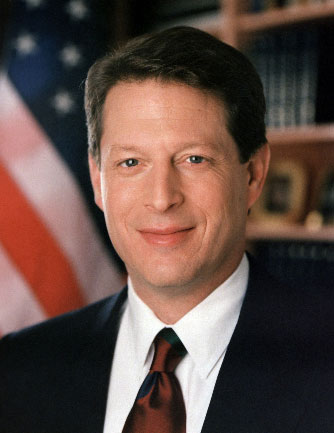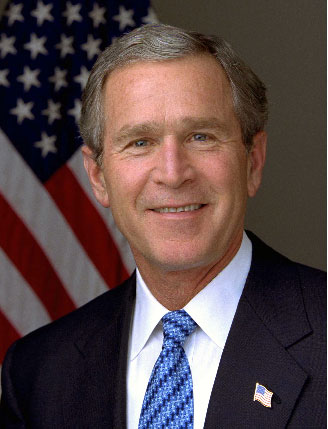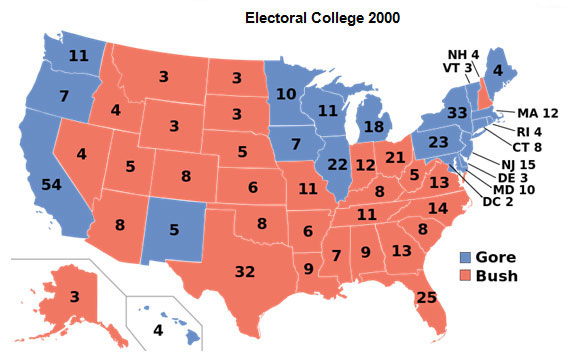

Al Gore |
George W. Bush |
 |
 |
The presidential election of 2000 was an important election not just because the decision determined the 43rd president, but also because the Supreme Court decided it. The candidates, Vice President Al Gore, a Democrat, and Governor of Texas, George W. Bush, a Republican, were involved in a close election. The election came down to the state of Florida. Initially, Al Gore was declared the winner in Florida, but before the end of the night, the votes in Florida were disputed, and George W. Bush was declared the winner.
Click on the link below to review a multimedia timeline of the night’s events.
Multimedia Timeline- Election Night 2000
After Bush was declared the winner, and Gore conceded victory (which he later renounced), it was determined that the vote was too close to call. Based on Florida law, an automatic recount was required. The nation would have to wait to determine who would be president. Disputes about voter irregularities, failed ballots, and a manual recount ensued.
Click the link to read more about the disputes from the 2000 election.
Election Dispute: November 8-January 20
There were several lawsuits filed in the dispute, and eventually the case of Bush v. Gore reached the U.S. Supreme Court. Read below to learn more about the case.
On December 12, 2000, the Supreme Court, in a 5-4 "per curiam" (non-specially authored) decision, ruled that the Florida Supreme Court's recount order was unconstitutional because it granted more protection to some ballots than to others, violating the Fourteenth Amendment's Equal Protection Clause. This clause forbids states from denying "to any person within their jurisdiction the equal protection of the laws." The Court argued that voting for a president constituted a "fundamental right" strictly guarded by the Equal Protection Clause, and that the Florida Supreme Court's order violated this right because it was "arbitrary." The Court alleged that the order contained standardless and unequal processes to divine the "intent of the voter" that were above and beyond the settled processes required by Florida election law.
-Excerpt from PBS - The Supreme Court
By throwing out the recount of the ballots, George Bush was declared the winner by judicial process. He became the 43rd President of the United States. Gore won the popular vote by 543,895 votes, but Bush won the electoral vote by 271 to 266. The map below illustrates the final electoral count.

Source: Electoral College 2000, Nkocharh, Wikimedia
As shown in the map, the 25 electoral votes in Florida went to George W. Bush, gaining victory over Al Gore.
The Supreme Court voted 5-4 in a per curiam decision. A per curiam vote is a decision submitted by the court as a whole. However, some of the justices wrote opinions that did not mirror that of the whole court.
Read the following excerpts from the Supreme Court opinions of Bush v. Gore. The opinions can be categorized as follows:
![]() Determine if the opinion that appears below supports the position of Bush (won the decision) or Gore (lost the decision) in the 2000 election. Click on the correct column (person) that the quote is from.
Determine if the opinion that appears below supports the position of Bush (won the decision) or Gore (lost the decision) in the 2000 election. Click on the correct column (person) that the quote is from.
There are numerous theories about the true winner of the election of 2000. There are theories which suggest that Bush won because the five justices who shared the majority opinion were all Republican appointees. One of the dissenting justices, Justice John Paul Stevens was quoted, “one thing . . . is certain. Although we may never know with complete certainty the identity of the winner of this year's presidential election, the identity of the loser is perfectly clear. It is the Nation's confidence in the judge as an impartial guardian of the rule of law."
In this lesson, you examined the constitutional principles of separation of powers and checks and balances. By learning more about the New Deal programs, Franklin D. Roosevelt’s presidency, and the election of 2000, you were able to examine how these events changed the relationship between the legislative, executive, and judicial branches.